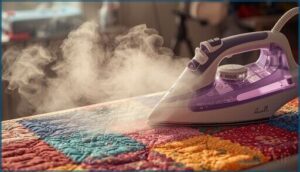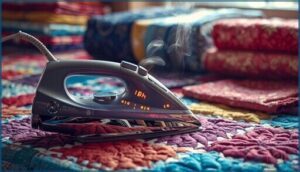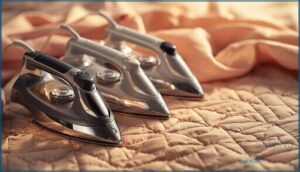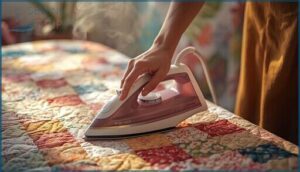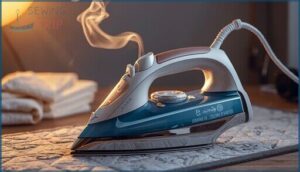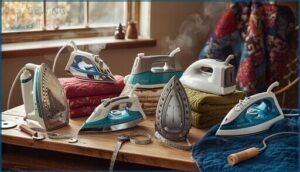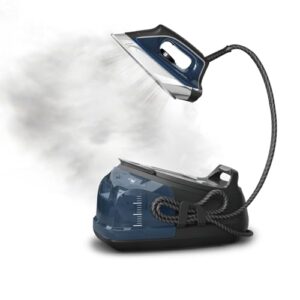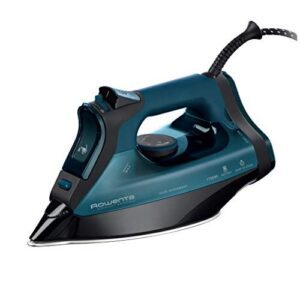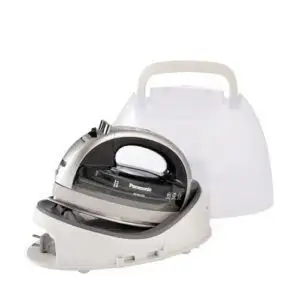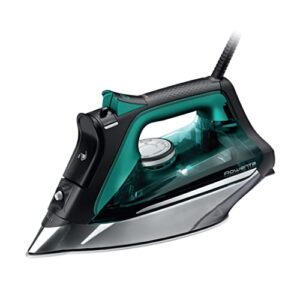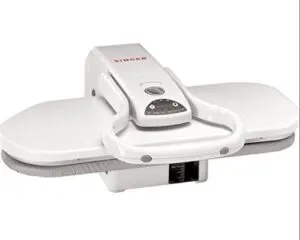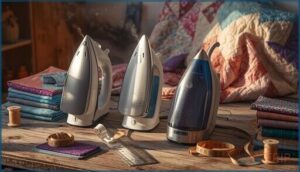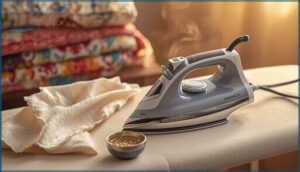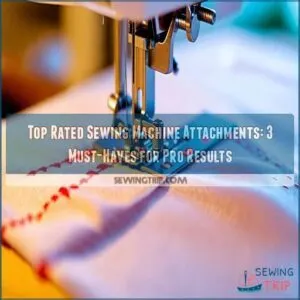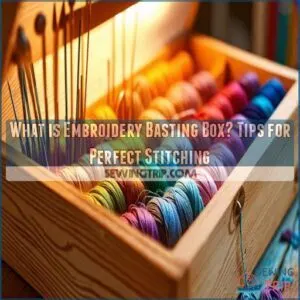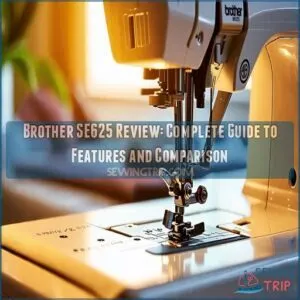This site is supported by our readers. We may earn a commission, at no cost to you, if you purchase through links.

A single scorched seam can ruin hours of careful piecing—ask any quilter who’s grabbed the wrong iron in a rush. The difference between an ordinary household iron and one designed for quilting isn’t just marketing talk. It’s the difference between flat, crisp seams that nest together perfectly and puckered fabric that throws off your entire block alignment.
Your iron does more heavy lifting in quilting than almost any other tool in your arsenal. The right one glides smoothly across delicate batiks without snagging, delivers consistent heat that won’t warp bias edges, and produces enough steam to coax stubborn seams into submission.
Whether you’re foundation piecing intricate medallions or pressing yards of backing fabric, choosing an iron that matches your quilting style will transform your finished projects from homemade to heirloom-worthy.
Table Of Contents
- Key Takeaways
- Key Features to Look for in Quilting Irons
- Types of Irons for Quilting
- Top 9 Best Irons for Quilting
- 1. Rowenta Perfect Steam Pro Iron Steamer
- 2. Rowenta Everlast Stainless Steel Steam Iron
- 3. Rowenta Steam Iron For Clothes
- 4. Professional Steam Iron For Clothes
- 5. Cordless Steam Iron By Panasonic
- 6. Rowenta Eco Steam Iron System
- 7. Rowenta Pro Steam Iron System
- 8. Black and Decker Digital Steam Iron
- 9. Singer Magic Steam Presser
- How to Choose The Right Quilting Iron
- Maintenance and Safety Tips for Quilting Irons
- Frequently Asked Questions (FAQs)
- Conclusion
Key Takeaways
- Choosing a quilting iron with strong steam power, precise temperature control, and a stainless steel soleplate will help you achieve crisp, flat seams and prevent fabric distortion.
- Comfort and safety matter—look for irons that are well-balanced, ergonomic, and include safety features like automatic shutoff and certifications.
- Different types of irons, like cordless, steam presses, and mini models, suit various quilting needs, so match the iron style to your project size, travel habits, and workspace.
- Regular maintenance, using distilled water, and correct pressing techniques will keep your iron running smoothly and extend its lifespan, ensuring consistent results.
Key Features to Look for in Quilting Irons
Not all irons are built the same, and for quilting, the right features can make the difference between smooth, crisp seams and frustrating wrinkles that just won’t budge. You’ll want to zero in on a few key specs that matter most for handling layers of fabric and keeping your projects looking professional.
Let’s break down what you should prioritize when shopping for your next quilting iron.
Steam Power and Performance
When you’re choosing quilting irons, steam power makes all the difference in how smoothly your fabric lays flat. Look for models delivering at least 65 grams per minute of continuous steam output—this heating efficiency softens fibers fast and eliminates wrinkles without multiple passes.
A generous tank capacity, like 10 to 12 ounces, keeps you working longer between refills, while strong steam delivery enhances those crisp seams you’re after.
Precise temperature control is essential for handling different fabrics.
Adjustable Heat Settings
Temperature control paired with steam power protects your fabrics from scorching and keeps heat consistency throughout your project. Look for quilting irons offering at least three adjustable heat settings—low for synthetics, medium for wool blends, high for cotton.
This temperature precision gives you versatility across mixed-fabric projects, with 75% of quilters preferring multiple settings for better control and fabric safety. Many quilters find a cordless iron ideal for ease of use.
Soleplate Materials and Glide
The soleplate material determines your ironing experience and gliding efficiency. Stainless steel soleplates offer the smoothest glide and exceptional durability—they resist scratches and maintain consistent heat without frequent fluctuations.
Ceramic soleplates prevent scorch marks on delicate fabrics but wear faster as their coating degrades.
For surface technology that balances performance with longevity, stainless steel remains the top choice for serious quilters.
Weight, Balance, and Ergonomics
Beyond soleplate quality, your iron’s weight and design directly impact your comfort during long quilting sessions. Look for models between 2.5 and 3.5 pounds—heavy enough to press seams effectively without exhausting your wrist.
Proper weight distribution and iron balance prevent strain, while an ergonomic handle with a comfortable grip reduces fatigue by up to 25% during repetitive pressing motions.
Durability and Safety Features
Peace of mind is priceless, especially when Fire Protection and iron safety features are built into your daily tools. Opt for quilting irons with Safety Certifications—like UL or CE marks—and demand Material Durability from aluminum or stainless steel parts.
Features such as electronic guards, automatic shutoff, and smart Thermal Control work together to minimize hazards and guarantee the durability and safety of irons for years.
Types of Irons for Quilting
Quilting irons come in more shapes and sizes than you might expect, each with its own perks and quirks. Finding the right one can make your projects smoother and your results more reliable.
Let’s take a closer look at the types of irons you’ll want to explore.
Conventional Steam Irons
Looking for pure muscle in your quilting iron? Conventional steam irons bring that steam power you crave, with 1500 to 1800 watts and up to 400 steam holes for enhanced steam distribution.
Adjustable heat settings and well-designed soleplate materials mean Fabric Safety comes first, while regular Iron Maintenance keeps gliding smooth—key for all your favorite quilting techniques.
Cordless Irons
Freedom on your ironing board—cordless irons like the Panasonic Cordless Steam Iron deliver pure convenience. With a lightweight, portable design and up to 15 minutes of steady steam per charge, you move easily around edges and quilt seams.
Recharge time is quick, and smart iron safety features keep things worry-free. If cordless benefits and steam efficiency matter, this upgrade earns its keep.
Steam Presses
Ever wrestled bulky quilt tops on a standard iron? A steam press like the Singer EPS2 transforms your routine—think fast, even steam distribution and larger pressing surfaces.
With efficient pressing techniques and gentle fabric handling, you can flatten seams in wide sections. Less time ironing, more time quilting.
Iron maintenance is simple, making a steam press a real boost to quilting efficiency.
Digital and Hybrid Irons
Craving Digital Precision for your quilting setup? Digital and hybrid irons deliver just that—think pinpoint Temperature Control, easy-to-use digital displays, and Sensor Technology that adjusts steam on cue.
Hybrid Benefits blend steam iron power with cordless mobility, while overheat protection and autoshutoff keep your workspace safe.
These quilting irons take the guesswork out of fabric care—especially when consistency truly matters.
Mini Irons for Quilting
Ever tried pressing tiny seams with a regular iron? Mini irons for quilting are your trusty sidekicks. These compact tools deliver precision pressing and unbeatable seam detailing, all with ergonomic design and smart portability factors. Perfect for travel quilting or tight spaces, a quality mini iron gives you control and comfort when working on detailed quilting projects.
- Simple seam detailing
- Lightweight, travel-friendly design
- Ideal for intricate quilting projects
- Safe, ergonomic grips for comfort
Top 9 Best Irons for Quilting
With so many quilting irons on the market, choosing the right one can feel overwhelming. To help you cut through the noise, I’ve gathered the top options that stand out in 2025.
Here’s a closer look at the best irons for quilting this year.
1. Rowenta Perfect Steam Pro Iron Steamer
If you’re seeking powerhouse steam performance with thoughtful details, the Rowenta Perfect Steam Pro (Rowenta DG8624) earns its spot among top quilting irons. Its 430g steam boost and 400-hole stainless steel soleplate cut through stubborn wrinkles in fewer passes.
The ergonomic design and calc collector make it easy on your hands and maintenance routine.
Add in the large water tank, safety alerts, and fine steam vents—this steam iron truly aids efficient quilting sessions without slowing you down.
Best For: Quilters and sewing enthusiasts who want fast, professional results with minimal effort and easy maintenance.
- Powerful 430g/min steam boost and 400-hole soleplate for fast, even wrinkle removal
- Ergonomic, lightweight design with a large removable water tank for extended use
- Built-in calc collector and anti-leak features keep maintenance simple and fabrics protected
- Automatic shut-off can interrupt long projects if you pause too long
- Water tank may need frequent refills during back-to-back quilting sessions
- Some users report issues with electronic controls and customer support
2. Rowenta Everlast Stainless Steel Steam Iron
When consistent steam performance matters most, the Rowenta Everlast (DW7180) answers the call with its 1750W punch and precision Soleplate Tech. Four hundred steam vents mean even thick quilting cotton gives in quickly, while a stainless steel soleplate glides with ease at every turn.
Its patented Anti-Calc System saves you headaches down the road, making maintenance a breeze. Comfortable in your hand, with ergonomic design and smart Warranty Safety features, this steam iron is built for quilters who don’t settle for shortcuts.
Best For: Quilters and sewists who need powerful, consistent steam and easy maintenance for frequent, detailed fabric work.
- Stainless steel soleplate with 400 microsteam holes glides smoothly and provides even steam for stubborn wrinkles.
- Anti-Calc system and self-cleaning features extend the iron’s life, especially when using hard tap water.
- Ergonomic handle, precision tip, and a large water tank make long sessions and detailed projects more comfortable.
- Requires frequent water refills during intense steam use or larger projects.
- Water level can be hard to see, making it tricky to know when to refill.
- Some users report a plastic smell at first and issues with durability or customer service.
3. Rowenta Steam Iron For Clothes
The Rowenta steam iron for clothes stands out in steam iron reviews for its powerful steam output and ultra-smooth Soleplate Glide. With up to 400 active steam holes, it presses stubborn seams and bulky blocks flat in fewer passes—think smoother backs and crisper points.
Temperature Control is straightforward, letting you dial in for cotton, silk, or blends. Durability is solid, too, from the stainless steel soleplate to its anti-calc features.
Its ergonomic handle keeps long piecing sessions comfortable, making it a go-to among quilting irons.
Best For: Home sewers, quilters, or anyone who wants powerful steam and precision for detailed ironing jobs.
- Steam output is strong and consistent, making quick work of tough wrinkles.
- Stainless steel soleplate glides smoothly and reaches tight spots with its precision tip.
- Easy temperature control and vertical steam options make it versatile for all fabrics.
- Some users find it heavy to handle, especially for long sessions.
- Water tank may need frequent refills during heavy use.
- No on-off switch; must be unplugged to power down.
4. Professional Steam Iron For Clothes
When you’re chasing professional results, a true Professional Steam Iron for Clothes delivers with industrial wattage—often 1700 watts or more—and an ergonomic design built for long quilting sessions.
Expect continuous steam that powers through thick seams with ease. Safety certifications and sophisticated features like auto shut-off add peace of mind, while anti-calc systems and sturdy construction guarantee commercial durability.
For anyone who values steam power and performance, this kind of steam iron earns rave marks in steam iron reviews and stands tall among quilting irons.
Best For: Home or professional users who want powerful steam output and reliable results for a wide range of fabrics.
- Powerful 1700-watt steam blasts through wrinkles and thick seams with ease
- Easy electronic temperature control and steam adjustment provide versatility for different fabrics
- Retractable cord and auto shutoff feature add convenience and peace of mind
- Some users find the iron heavy, which can cause fatigue during longer sessions
- Water reservoir is difficult to fill and see the level due to its dark color
- Occasional issues with retractable cord functionality and customer service
5. Cordless Steam Iron By Panasonic
Freedom is the name of the game with the Panasonic NIWL600 Cordless Iron. If you’re tired of fighting tangled cords, cordless ironing delivers pure quilting bliss—especially when you need to press large blocks with steady steam control.
The stainless-steel soleplate glides smoothly, and Panasonic features like a detachable water tank and rapid heat-up keep your quilting flow uninterrupted.
Plus, with the auto shutoff feature and thoughtful iron safety details, you get peace of mind while you power through precise seams and delicate fabrics.
Best For: Quilters and crafters who want cordless convenience, fast heat-up, and a smooth glide for precise, uninterrupted ironing.
- Cordless design with rapid heat-up and 360° soleplate lets you move freely and tackle big projects without tangles.
- Detachable water tank and anti-drip system keep ironing clean, easy, and quick to refill.
- Automatic shut-off and heat-resistant carrying case add peace of mind and travel-ready safety.
- Needs frequent returns to the base for reheating, which can interrupt your flow.
- Some users find the iron doesn’t get as hot as traditional corded models.
- Higher price point for features compared to standard irons.
6. Rowenta Eco Steam Iron System
Efficiency-minded quilters, take note: the Rowenta Eco Steam Iron System—like the DG8624—offers Eco Mode for impressive energy savings without sacrificing steam power and performance.
Over 400 microholes in its stainless-steel soleplate guarantee superior steam distribution, tackling thick seams and cotton with ease.
Thoughtful features like a 3-way auto shutoff, anti-calc, and anti-drip boost iron durability and user experience.
For anyone serious about both sustainability and precise results, this steam iron promises smooth glides, consistent results, and years of reliable service.
Best For: Efficiency-focused home sewers, quilters, and anyone who wants powerful steam with lower energy use and easy maintenance.
- Even, powerful steam with over 400 microholes for thorough, fast ironing.
- Eco Mode cuts energy use by up to 25%, making it eco-friendly and cost-effective.
- Durable stainless-steel soleplate, anti-calc, and 3-way auto-off for safety and long lifespan.
- Heavier than competing irons, which can cause fatigue during long sessions.
- Cord length may be too short for some setups, limiting flexibility.
- High price and longer cool-down time compared to basic irons.
7. Rowenta Pro Steam Iron System
Let’s talk precision and muscle: the Rowenta Pro Steam Iron System truly sets the bar for steam power and performance. With a powerful 1850 watts and a Microsteam 400 HD Laser Profile soleplate, you’ll see consistent Steam Output that makes light work of thick quilt layers and trickier seams.
Fine-tune your Steam Control for each fabric, and you’ll notice how Fabric Protection takes priority during every pass. Easy Iron Maintenance keeps the system running smoothly—ideal for quilters ready to advance their quilting techniques.
Best For: Dedicated home users and quilting enthusiasts who need a heavy-duty iron that can handle tough fabrics and detailed work with consistent steam.
- Professional-grade steam with 400 microsteam holes and precise control for stubborn wrinkles and thick quilting layers.
- Large, easy-to-fill water tank and ergonomic grip make extended ironing comfortable and efficient.
- Features like anti-calc, auto shut-off, and advanced soleplate tech ensure durability and safer use.
- Some may find the temperature dial stiff and the indicator light for warming up hard to notice.
- Water reservoir may leak during steam use and precision tip isn’t as sharp as some other models.
- Only auto shut-off (no manual off), and the two-prong plug is not ideal for UK or UAE users.
8. Black and Decker Digital Steam Iron
Looking for a quilting iron that blends modern precision with rugged build? The Black and Decker Digital Advantage D3030 shines with Digital Temperature Control and an ultra-smooth stainless steel soleplate, promising exceptional Soleplate Durability and easy gliding on fabric.
You’ll appreciate the dense Steam Performance for smooth seams, while its Ergonomic Design and weight make long sessions less tiring.
The three-way Auto-Shutoff Safety gives you peace of mind—whether you’re pressing tiny quilt blocks or giving clothes a crisp finish.
Best For: Quilters and home sewists who want digital control and strong steam for both heavy-duty ironing and precise fabric work.
- Digital temperature and steam settings for tailored fabric care.
- Durable stainless steel soleplate glides easily and resists scratches.
- Auto-clean and three-way auto shutoff add safety and convenience.
- Cord is long but not retractable, which can get in the way.
- Iron takes a while to cool down, so you need to handle with care.
- Requires regular cleaning to avoid leaks or mineral buildup.
9. Singer Magic Steam Presser
Steam presser in hand, you’ll press quilt tops as if you’ve borrowed magic from the dry cleaner. The Singer EPS2 Steam Press, with its expansive 24 x 9-inch plate and powerful bursts of steam, covers more fabric with every press than standard quilting irons.
Fabric protection is built-in, thanks to adjustable heat settings and an auto shut-off—no more worrying about scorching.
Whether you’re tackling bulk yardage or fussy blocks, this quilting tool transforms your ironing techniques into professional-grade pressing results.
Best For: Quilters, crafters, and home sewers who want fast, professional-quality pressing on large fabric pieces with less effort.
- Huge pressing surface covers more fabric at once, saving time on big projects.
- Adjustable heat and steam settings make it safe for a variety of fabrics, from silk to linen.
- Auto shut-off and locking handle boost safety, storage, and peace of mind.
- Some users report steam function issues or a learning curve, especially with tricky fabrics.
- Large size and 22-pound weight mean it needs a stable spot and isn’t super portable.
- Not suitable for use outside the US and Canada due to voltage limitations.
How to Choose The Right Quilting Iron
Choosing a quilting iron comes down to more than just picking the newest model on the shelf. Your projects, habits, and budget all play a part in what fits best. Here’s how you can find the right match for your quilting needs.
Matching Iron Features to Your Quilting Needs
Choosing the right quilting iron is like picking a trusty sidekick for your creative journey. If you love delicate appliqué, look for adjustable heat and precise steam control. Prefer straight, flat seams? Prioritize weight and a non-stick soleplate for smooth gliding.
Here’s a side-by-side glance to help narrow your Iron Selection:
| Feature Priority | Best Match for Quilters |
|---|---|
| Precise Steam Control | Expert Quilting Techniques |
| Comfortable Grip & Weight | Long-Sessions, Reduced Fatigue |
Considering Your Budget
Budget planning deserves as much care as any quilting project. Start with a price comparison, weighing financial priorities against the features of quilting irons—auto shut-off, steam burst, ergonomic design.
For some, affordable options shine; for others, top-rated quilting irons with longer warranties feel right. Iron recommendations often come down to balancing best steam iron for quilting with smart cost savings.
Evaluating Water Tank Capacity
When you weigh the cost against daily convenience, Water Tank Capacity deserves your full attention. A quilting iron with a generous tank lets you iron for longer stretches—no constant water refills breaking your rhythm.
But remember, greater Tank Size Variability affects Iron Weight Balance, so find a steam iron that offers both easy Water Refill Ease and manageable handling.
Importance of Cord Length and Portability
Once you’ve balanced water tank needs, think about cord length ergonomics and how portability will shape your quilting flow. A corded model with ample reach keeps you moving naturally, while portable or cordless irons open doors for travel—if you’re willing to accept some cordless iron limitations. Consider these trade-offs:
- Workspace cord management
- Cordless iron limitations
- Portability trade-offs
- Mini iron travel companion
- Travel iron benefits
Maintenance and Safety Tips for Quilting Irons
Taking care of your quilting iron keeps it working like new and helps you steer clear of safety headaches down the road. A few simple habits can make a big difference, whether you’re quilting every day or just now and then.
Here are some essential tips to help you protect your iron and your projects.
Cleaning and Preventing Mineral Buildup
Ever notice stubborn white flakes on your quilting iron? That’s mineral buildup muddying your hard work. Regular cleaning and maintenance of irons—think scale removal, tank maintenance, and soleplate cleaning—helps guarantee iron longevity.
Use the self-cleaning features and avoid letting tap water sit. With mindful iron care, you’ll keep your quilting results sharp and your iron running smooth.
Using Distilled Water
Distilled water is your secret weapon for iron care—say goodbye to mineral buildup, rusty stains, and clogged steam vents. Unlike tap water, it keeps your quilting irons humming along with consistent steam quality.
That means better results on your projects, less maintenance, and longer iron life. For the best quilting experience, make distilled water a non-negotiable part of your routine.
For the best quilting experience and iron longevity, make distilled water a non-negotiable part of your routine
Safe Storage Practices
After each quilting session, let your iron cool on its pad—never flat, always upright—for safe storage and risk reduction. Wrap the cord loosely to avoid hidden wear, using a dedicated pocket when possible. Store your iron in a dry, cool spot with protective accessories so those safety features (like automatic shutoff) and durable parts keep working longer.
- Let the iron cool fully on a heat-safe pad.
- Store cords in a loose coil, away from kinks.
- Use bags or bins to shield from dust and moisture.
Proper Ironing Techniques for Quilting Projects
When you’re pressing fabric and clothes for your sewing projects, lift and lower your quilting iron rather than sliding it—that’s the difference between pressing vs ironing.
Set your heat setting high for cotton, press seams flat on a firm pressing surface, and limit steam usage on bias edges. This technique keeps your quilting projects square and distortion-free.
Frequently Asked Questions (FAQs)
How does altitude affect iron performance?
At higher altitudes, your steam iron struggles—steam pressure drops, water boils sooner, and temperature control wobbles. That means heat settings and Iron Calibration need adjusting for effective steam power and performance.
High Elevation calls for smart Quilting Adjustments!
Can quilting irons remove fusible web residue?
Fusible Web Removal is possible with a steam iron—just use the right temperature control and steam setting optimization.
Iron Soleplate Cleaning after adhesive buildup keeps residue-free ironing simple, while a pressing cloth prevents further mess.
Are there eco-friendly options for quilting irons?
You’ll find plenty of eco-friendly options, like the Rowenta 6080 EcoIntelligence steam iron, which balances energy efficiency with powerful performance.
Eco Irons now feature Sustainable Materials, Green Quilting designs, and energy saving modes for a lighter impact.
How do different power voltages impact ironing?
Picture adjusting a dimmer switch—less voltage means your iron takes longer to heat and can’t produce the same steam power.
Lower volts reduce heat control and steam output, affecting Power Consumption and Energy Efficiency, especially at higher watts.
What are the warranty options for quilting irons?
Warranty terms for quilting irons usually range from one to three years, depending on brand and model. Manufacturer support often includes basic repairs, while extended coverage or “iron insurance” protects costly irons against defects. Always save receipts for warranty claims!
Can you travel with a quilting iron on airplanes?
You can take a quilting iron—like a mini steam iron or traditional steam iron—on airplanes under TSA guidelines, but follow airline regulations.
Always pack a fully cooled iron in a protective case for travel safety and flight restrictions.
Are quilting irons safe to use on vintage fabrics?
It’s true: the safest quilting iron for vintage fabrics can sometimes be your riskiest tool.
Proper Heat Settings, gentle Steam Control, and regular Iron Maintenance turn iron safety features into your best defenses against fabric damage during vintage care and ironing fabric and clothes.
How long does it take for irons to heat up?
Most quilting irons heat up in about 2 minutes, thanks to efficient watts and digital temperature controls.
Iron efficiency and heating speed depend on power consumption, soleplate material, and features like adjustable heat settings for stable, controlled temperature.
Can you use essential oils in a quilting iron?
Adding essential oils to your quilting iron might sound like DIY aromatherapy, but you’ll end up with clogged steam vents and damaged parts.
Stick to distilled water—it’s safer for your quilting iron and protects delicate fabrics from steam vapor hazards.
Conclusion
Picture your favorite quilt, every seam pressed sharp, colors blooming without a trace of stubborn wrinkles. Selecting the best irons for quilting isn’t just about fancy features—it’s about enabling your hands to create with confidence and ease.
The right iron becomes an extension of your craft, smoothing the path from idea to heirloom. Invest thoughtfully, maintain your tools well, and you’ll be ready to turn every fabric scrap into a masterpiece that truly lasts.

